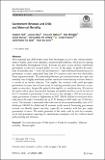Government revenue and child and maternal mortality
Abstract
Most maternal and child deaths result from inadequate access to the critical determinants of health: clean water, sanitation, education and healthcare, which are also among the Sustainable Development Goals. Reasons for poor access include insufficient government revenue for essential public services. In this paper, we predict the reductions in mortality rates — both child and maternal — that could result from increases in government revenue, using panel data from 191 countries and a two-way fixed-effect linear regression model. The relationship between government revenue per capita and mortality rates is highly non-linear, and the best form of non-linearity we have found is a version of an inverse function. This implies that countries with small per-capita government revenues have a better scope for reducing mortality rates. However, as per-capita revenue rises, the possible gains decline rapidly in a non-linear way. We present the results which show the potential decrease in mortality and lives saved for each of the 191 countries if government revenue increases. For example, a 10% increase in per-capita government revenue in Afghanistan in 2002 ($24.49 million) is associated with a reduction in the under-5 mortality rate by 12.35 deaths per 1000 births and 13,094 lives saved. This increase is associated with a decrease in the maternal mortality ratio of 9.3 deaths per 100,000 live births and 99 maternal deaths averted. Increasing government revenue can directly impact mortality, especially in countries with low per- capita government revenues. The results presented in this study could be used for economic, social and governance reporting by multinational companies and for evidence-based policymaking and advocacy.
Citation
Hall , S , Illian , J , Makuta , I , McNabb , K , Murray , S W , O'Hare , B A-M , Python , A , Zaidi , S H A & Bar-Zeev , N 2020 , ' Government revenue and child and maternal mortality ' , Open Economies Review , vol. First Online . https://doi.org/10.1007/s11079-020-09597-0
Publication
Open Economies Review
Status
Peer reviewed
ISSN
0923-7992Type
Journal article
Rights
Copyright © The Author(s) 2020. This article is licensed under a Creative Commons Attribution 4.0 International License, whichpermits use, sharing, adaptation, distribution and reproduction in any medium or format, as long as you giveappropriate credit to the original author(s) and the source, provide a link to the Creative Commons licence, andindicate if changes were made. The images or other third party material in this article are included in thearticle's Creative Commons licence, unless indicated otherwise in a credit line to the material. If material is notincluded in the article's Creative Commons licence and your intended use is not permitted by statutoryregulation or exceeds the permitted use, you will need to obtain permission directly from the copyright holder.To view a copy of this licence, visithttp://creativecommons.org/licenses/by/4.0/
Description
Funding: The Global Challenges Research Fund, the Scottish Funding Council and the Professor Sonia Buist Global Health Research Fund.Collections
Items in the St Andrews Research Repository are protected by copyright, with all rights reserved, unless otherwise indicated.

